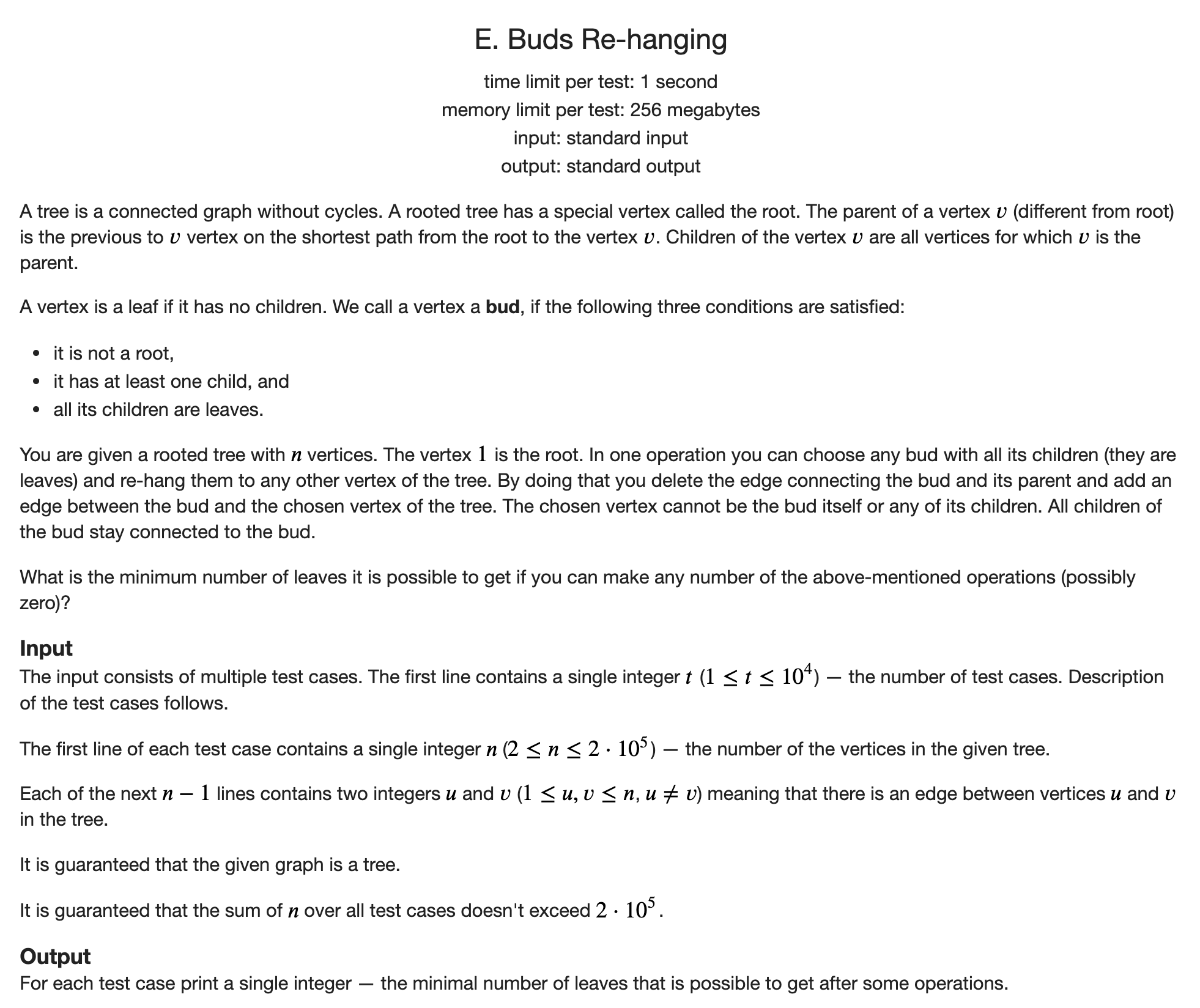Codeforces Global Round 16 E. Buds Re-hanging (思维,树)

-
题意:一颗\(n\)个点的树,定义bud为某个点至少有一个儿子,所有儿子均为叶子结点且这个点不为根,你可以将任意一个bud和它的所有儿子移动到另外一个顶点上,可以操作任意次,问最后的叶子结点数最少是多少.
-
题解:假如我们将一个bud移到另一个叶子结点上后,bud的父亲变成了一个叶子结点,那么会发现,总叶子结点数是不变的,叶子结点想要减少,就必须满足移动后,bud的父亲不会变成一个叶子结点,很明显,如果bud的父亲是根,那么肯定满足这个条件.所以我们首先把所有bud拆了接到根结点上,那么假设此时的bud数为\(k\),此时的叶子结点数为\(n-k-1\),如果根结点上没有任何儿子是叶子结点,那么先确定一个bud,将的bud依次接到它的叶子结点上,每次叶子结点减少1,一共移动\(k-1\)次,最后答案为\(n-k-1-(k-1)\).如果根结点上有个儿子是叶子结点,那么将\(k\)个bud依次接上去,最后答案为\(n-k-1-k\).具体写法就是dfs,对于一条链,最后一个点一定是叶子结点,叶子结点的父亲是一个bud,bud的父亲是一个叶子结点,就这样分奇偶判断即可.
-
代码:
#include <iostream> #include <iomanip> #include <cstdio> #include <cstring> #include <cmath> #include <algorithm> #include <stack> #include <queue> #include <vector> #include <map> #include <set> #include <unordered_set> #include <unordered_map> #define ll long long #define db double #define fi first #define se second #define pb push_back #define me memset #define rep(a,b,c) for(int a=b;a<=c;++a) #define per(a,b,c) for(int a=b;a>=c;--a) const int N = 1e6 + 10; const int mod = 1e9 + 7; const int INF = 0x3f3f3f3f; using namespace std; typedef pair<int,int> PII; typedef pair<ll,ll> PLL; int gcd(int a,int b){return b?gcd(b,a%b):a;} int lcm(int a,int b){return a/gcd(a,b)*b;} int u,v; vector<int> edge[N]; int cnt[N]; void dfs(int u,int fa){ bool leaf=false; for(auto to:edge[u]){ if(to==fa) continue; dfs(to,u); if(cnt[to]==1) leaf=true; //表示这个点的儿子有叶子结点 } if(u!=1){ if(leaf) cnt[u]=2; else cnt[u]=1; } } int main() { #ifdef lr001 freopen("/Users/somnus/Desktop/data/in.txt","r",stdin); #endif #ifdef lr002 freopen("/Users/somnus/Desktop/data/out.txt","w",stdout); #endif int _; scanf("%d",&_); while(_--){ int n; scanf("%d",&n); for(int i=1;i<=n;++i) edge[i].clear(); for(int i=1;i<n;++i){ scanf("%d %d",&u,&v); edge[u].pb(v),edge[v].pb(u); } dfs(1,-1); int flag=0; for(auto to:edge[1]){ if(cnt[to]==1) flag=1; } ll ans=0; for(int i=1;i<=n;++i) ans+=2*(cnt[i]==2); printf("%lld\n",n-ans-flag); } return 0; }
𝓐𝓬𝓱𝓲𝓮𝓿𝓮𝓶𝓮𝓷𝓽 𝓹𝓻𝓸𝓿𝓲𝓭𝓮𝓼 𝓽𝓱𝓮 𝓸𝓷𝓵𝔂 𝓻𝓮𝓪𝓵
𝓹𝓵𝓮𝓪𝓼𝓾𝓻𝓮 𝓲𝓷 𝓵𝓲𝓯𝓮

